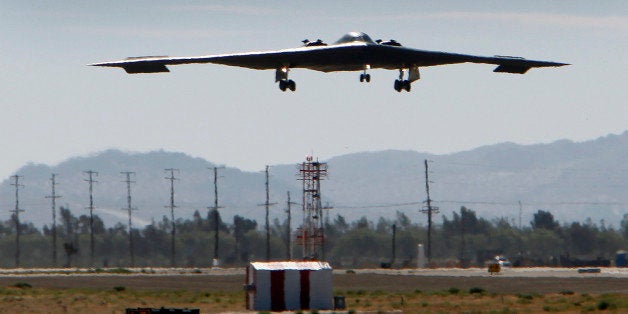
The ink is barely dry on the Air Force's press release announcing the selection of Northrop Grumman as the prime contractor to build 100 new bombers, and the bomber lobby is already pushing to double that amount.
The recommendation to dramatically up the Air Force's bomber buy came from a study by the Mitchell Institute for Aerospace Studies, which is far from a disinterested party. The institute is affiliated with the Air Force Association (AFA), which routinely advocates for more spending on virtually anything that flies, as might be expected given its membership of retired Air Force personnel. But the AFA is far more than an alumni association.
In addition to individual dues, AFA's operations depend on generous membership fees from over 600 companies, including Northrop Grumman, Lockheed Martin and Boeing, the firms that competed for the bomber contract. AFA's web site brags about its crack government relations staff, which advocates on issues of material concern to its member companies, such as "recapitalizing the Air Force" and "strengthening the nuclear mission." And the association's annual meeting is part networking event, part arms fair, with promotional exhibits run by aerospace contractors taking up a healthy chunk of real estate in the hotel that hosts the event.
All of the above-mentioned activities are perfectly legal, business-as-usual tactics in Washington, where special interest lobbying is a growth industry. But readers -- and taxpayers -- should take these corporate connections into account when assessing the objectivity of pro-bomber pieces like the Mitchell Institute report.
Of course, even interested parties can be right some of the time. But that is not the case with respect to the new bomber, which is both unnecessary and unaffordable under current circumstances. As Tom Collina and Will Saetren of the Ploughshares Fund point out in a recent piece in Aviation Week and Space Technology, the 100 bombers currently proposed will cost at least $1 billion each once development costs and inflation are taken into account. And that doesn't even count classified funding in the Pentagon's so-called "black budget." Nor does it reflect the cost overruns that have been a chronic feature of Air Force aircraft procurement programs of the past three decades.
Given the immense costs of current plans, building 200 bombers instead of the proposed 100 does not make fiscal sense, particularly given all the other programs on the Air Force's agenda. Over the next three decades the Air Force wants to buy over 2,400 F-35 combat aircraft, the most expensive weapons program in the history of Pentagon procurement.
In its most recent statement of policy AFA suggests that along with new bombers and fighters, the Air Force should also "recapitalize" its "tanker, trainer, combat search and rescue, and intelligence, surveillance and reconnaissance platforms." There is no conceivable set of circumstances under which the Air Force could afford to purchase all of these aircraft in the next decade or more. Something will have to give.
Another substantial source of budgetary pressure that argues against buying large numbers of new bombers is the $1 trillion plan to modernize the entire nuclear triad over the next three decades - not just bombers but ballistic missile submarines, land-based intercontinental ballistic missiles (ICBMs) and even a redundant new nuclear-tipped Air-Launched Cruise Missile at a hefty cost of at least $25 billion.
As Collina and Saetren have suggested, a sensible approach to reducing the pressure on the Air Force's budget without undermining U.S. security would be to shelve the new cruise missile and slow down the bomber program. Former Secretary of Defense William Perry is also opposed to building the new ALCM.
The United States currently has thousands of nuclear warheads when hundreds would do to deter any other nation from attacking the U.S. with nuclear weapons. Once that fact is recognized and translated into policy, even if it is some years down the road, the lack of any possible "need" for the trillion-dollar triad will become even more evident.
In addition, the current bomber force can operate safely and effectively for decades, so there is no rush to build the bomber for conventional missions either.
So, while budgetary discipline and a clear-eyed view of U.S. security needs argue against more bombers -- and certainly against arming any of them with new Air-Launched Cruise Missiles -- don't expect the major aerospace contractors or their allies at AFA to sit silently by and allow this to happen. Northrop Grumman has already begun an extensive advertising campaign on behalf of the new bomber, now referred to as the B-3. And the company will be back on Capitol Hill every year to press for maximum funding for the plane.
There are a couple of hitches that may undercut Northrop's campaign, however. Not only will it have to fend off challenges by Lockheed Martin and Boeing to the Air Force's decision to award it the bomber contract in the first place, but if its two rivals don't wrest the bomber contract from Northrop they will press their own programs -- like the tanker and the F-35 -- at the expense of the bomber. So some of the lobbying power of the military-industrial complex will be siphoned off into inter-company rivalries. And continued concerns about overspending at the Pentagon -- across the political spectrum -- will also give the bomber lobby a run for its money.
It's not inevitable that the Air Force buy 100 bombers, much less 200, if actual security and budgetary imperatives are allowed to trump special interest pleading. Congress and the administration have a chance to do the right thing, and they should be vigorously pressed to do so.
William D. Hartung is the director of the Arms and Security Project at the Center for International Policy.
